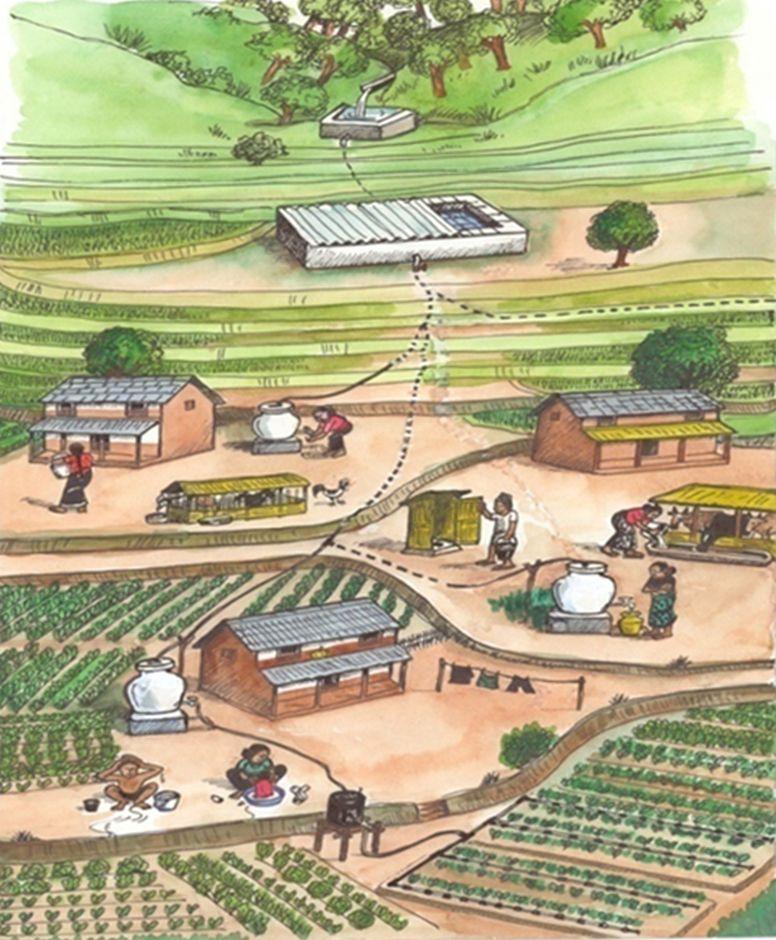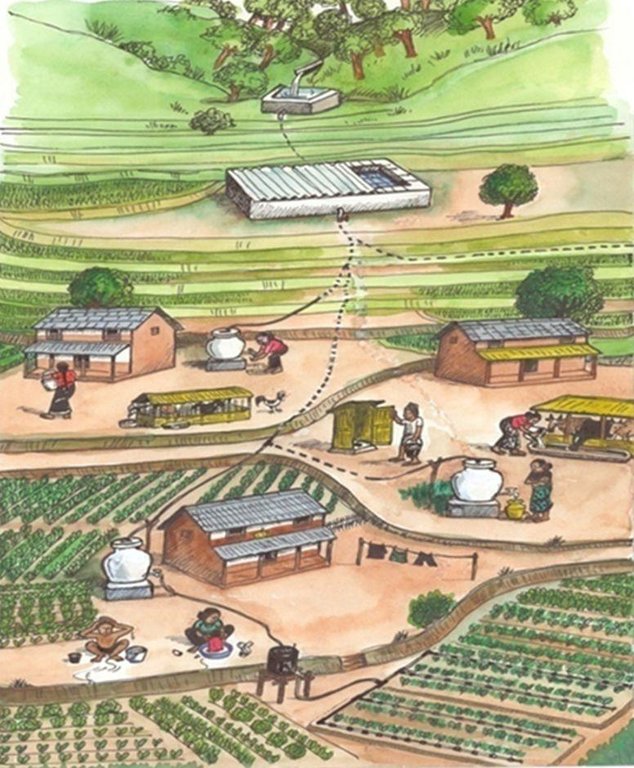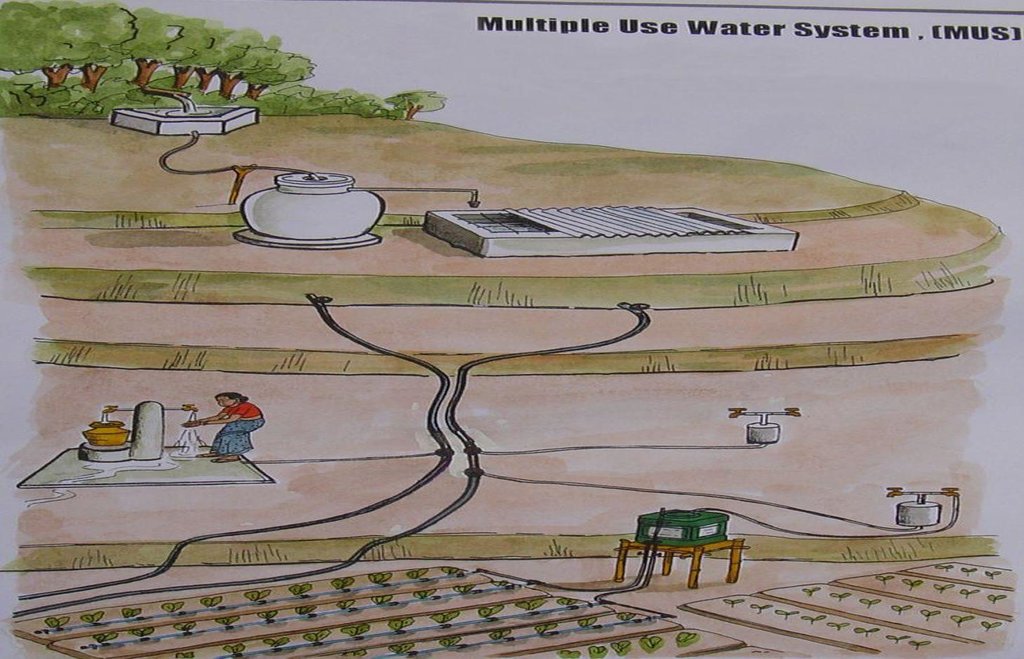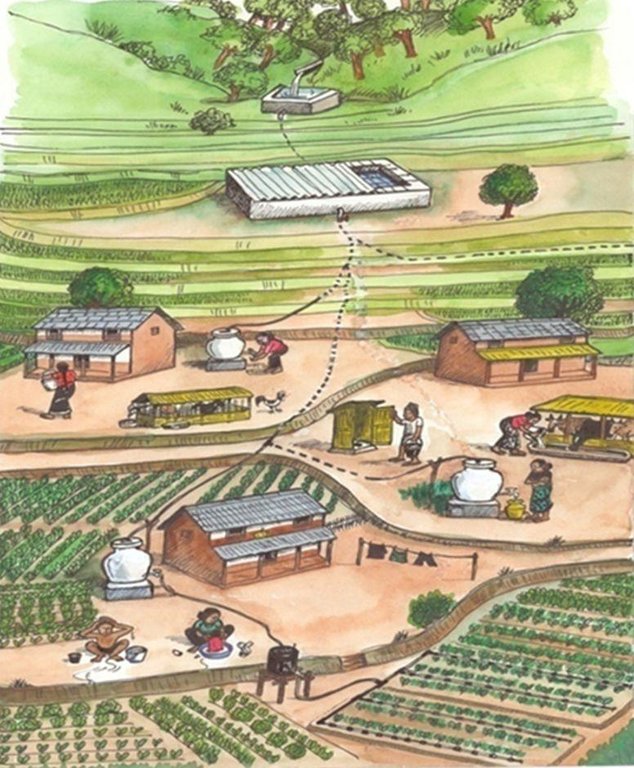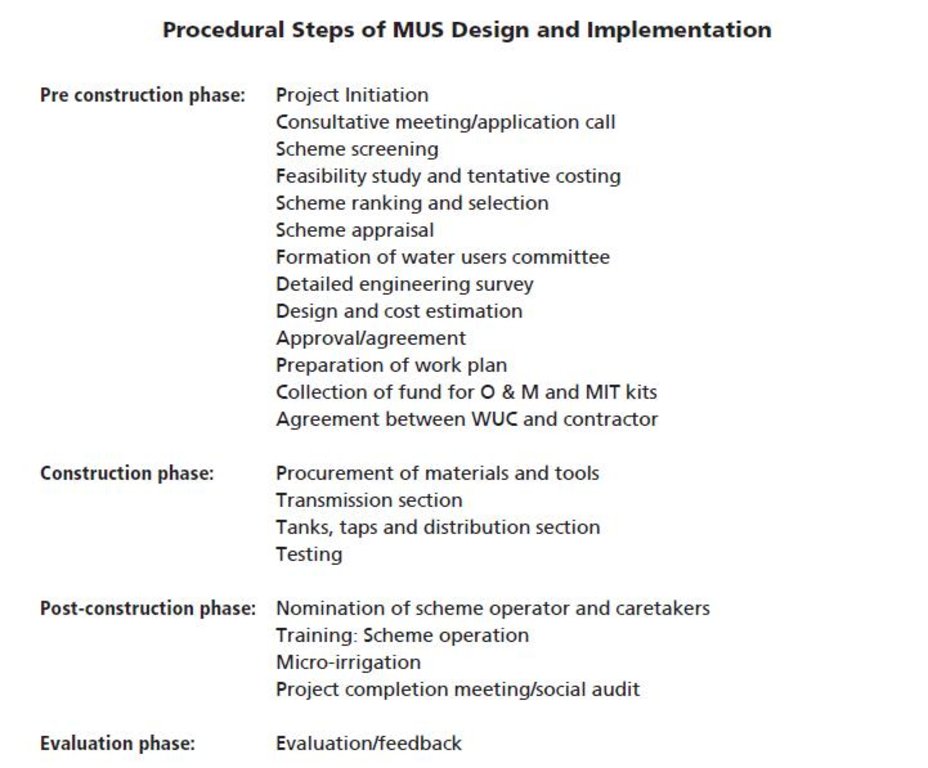A multiple-use water system [النيبال]
- تاريخ الإنشاء:
- تحديث:
- جامع المعلومات: Shreedip Sigdel
- المحرر: –
- المُراجع: Fabian Ottiger
Bahu uddhasaya Pani prayog pranali (Main contributor: Parmananda Jha, IDE/Nepal)
approaches_2532 - النيبال
عرض الأقسام
توسيع الكل طي الكل1. معلومات عامة
1.2 تفاصيل الاتصال بالأشخاص الرئيسيين لمصدر المعلومات والمؤسسات المعنية بتقييم وتوثيق النهج
متخصص في الإدارة المستدامة للأراضي:
Jha Parmananda
98487 28274 / 97495 12791 (M)
pjha@idenepal@org / jhap-2003@yahoo.com
Food Security Project, Regional Office, Banke Bagiya, Shantinagar,Nepalgunj
النيبال
اسم المؤسسة (المؤسسات) التي سهلت توثيق/تقييم النهج (إذا كان ذلك على صلة)
iDE Nepal (iDE Nepal) - النيبالاسم المؤسسة (المؤسسات) التي سهلت توثيق/تقييم النهج (إذا كان ذلك على صلة)
ICIMOD International Centre for Integrated Mountain Development (ICIMOD) - النيبال1.3 الشروط المتعلقة باستخدام البيانات الموثقة من خلال WOCAT
متى تم تجميع البيانات (ميدانيا)؟:
01/03/2013
يوافق جامع المعلومات والشخص (لاشخاص) الرئيسي لمصدر المعلومات على الشروط المتعلقة باستخدام البيانات الموثقة من خلال WOCAT:
نعم
2. وصف نهج الإدارة المستدامة للأراضي
2.1 وصف موجز للنهج
A multiple-use water system gives a community access to water for domestic use and water for crop irrigation.
2.2 وصف تفصيلي للنهج
وصف تفصيلي للنهج:
Aims / objectives: A multiple-use water system (MUS) is a combined water facility that has proven useful as a means of providing drinking water and water for irrigation for smallholder farmers in the hilly areas of Nepal. Water is collected by gravity from a highland source into a holding tank and is shared by means of distribution lines, domestic tap stands, and irrigation off-take lines. It can also support application of micro-irrigation technologies (MIT) such as drip and micro sprinkler irrigation systems.
Methods: MUS is a community-managed system that caters mainly to smallholder landowners and marginal households in rural hilly areas. When properly implemented, it can help to alleviate poverty and increase food security for poor and marginalized groups. The first priority is to provide drinking water and water for domestic use to the community; any excess water is used for agriculture and irrigation.
Stages of implementation: The following points should be taken into consideration before a community establishes a MUS:
• The source of water should be clear of water-rights issues
• The water should be plentiful and of good quality
• There needs to be a sufficient drop in gradient between the source and the tank if the water is to be collected by gravity. If the drop is not sufficient, users should be prepared to consider lifting the water.
• The distance between the source and the village should be less than 3 km.
• The community should be ready to contribute unskilled labour as part of their contribution to the project.
• The community should be ready to put aside some funds for operational and maintenance costs; these funds can, in part, also be collected in the form of monthly users' fees.
• At least 70% of the water users should be ready to adopt micro-irrigation technologies (MIT) such as drip and sprinkler irrigation.
2.3 صور عن النهج
2.5 البلد/المنطقة/المواقع التي تم تطبيق النهج فيها
البلد:
النيبال
مزيد من التفاصيل حول الموقع:
Kaski, Lamjunj, Tanahun, Dhading, Sangjya, Gulmi, Arghakhanchi, Palpa, Udayapur, Pyuthan, Rolpa, Ruk
2.7 نوع النهج
- قائم على مشروع/برنامج
2.8 الغايات/الأهداف الرئيسية للنهج
The Approach focused mainly on other activities than SLM (Collect water from a small-scale source and distribute it both for domestic use and for the production of vegetables and high value crops)
• To provide a regular supply of water for domestic and agricultural use
• To supply water for micro-irrigation technologies such as drip and sprinkler irrigation systems
• To improve health and sanitation
• To help smallholder landowners improve their incomes and livelihoods as well as to adapt to climate change by having access to a regular supply of water so that they can grow crops regardless of changes
• To conserve water by using it more wisely
The SLM Approach addressed the following problems: The community needs to prioritize how it will partition the water for domestic use and for irrigation.
2.9 الظروف التي تمكن أو تعيق تنفيذ التقنية/التقنيات المطبقة بموجب النهج
المعايير والقيم الاجتماعية /الثقافية/ الدينية
- معيق
Management and operation of system
Treatment through the SLM Approach: Strong social mobilization is needed
الإطار القانوني (حيازة الأراضي، وحقوق استخدام الأراضي والمياه)
- تمكين/تمكيني
The existing land ownership, land use rights / water rights helped a little the approach implementation: Since this approach uses small spring sources of water, there is usually only a minimum risk of conflict for water use. When the water source is registered with the local authorities, it helps to reduce potential conflicts over water rights between communities.
المعرفة حول الإدارة المستدامة للأراضي، والوصول إلى الدعم الفني
- معيق
Water supply insufficient to meet the demand
Treatment through the SLM Approach: Increase the capacity of the storage tank
غير ذلك
- معيق
The community often cannot agree whether to scale up the domestic or the irrigation water supply.
Treatment through the SLM Approach: Concerned stakeholders need to confer and agree
3. المشاركة وأدوار الأطراف المعنية
3.1 أصحاب المصلحة المعنيون بالنهج وأدوارهم
- مستخدمو الأراضي المحليون/المجتمعات المحلية
This included women, men, dalits, janjati, brahmin, chhetri
- متخصصون في الإدارة المستدامة للأراضي / مستشارون زراعيون
- المعلمون / أطفال المدارس / الطلاب
- منظمة غير حكومية
IDE Nepal
- الحكومة الوطنية (المخططون، صانعو القرار)
3.2 انخراط مستخدمي الأراضي المحليين/المجتمعات المحلية في المراحل المختلفة للنهج
| انخراط مستخدمي الأراضي المحليين/المجتمعات المحلية | حدد من شارك وصف الأنشطة | |
|---|---|---|
| المبادرة/التحفيز | تفاعلي | The community comes to a consensus on their water needs. They identify a source that it is within the 3 km limit and investigate the water use rights. |
| التخطيط | التعبئة الذاتية | Technical aspects are dealt with; these include assessing the source to verify whether it has an adequate supply of water, assessing different schemes (for intake, take off, tap stands, and the like), preparing a design and estimating the cost, and discussing funding. |
| التنفيذ | التعبئة الذاتية | A users' committee is formed and the community provides unskilled labour. Technical assistance is provided by INGOs/NGOs. |
| الرصد/التقييم | التعبئة الذاتية | The work is monitored by the users' committee but monitoring and evaluation of technical aspects are provided by INGOs/NGOs at different times during the project. |
| Research | غير موجود |
3.3 مخطط التدفق (إذا كان متاحًا)
3.4 اتخاذ القرار بشأن اختيار تقنية/تقنيات الإدارة المستدامة للأراضي
حدد من الذي قرر اختيار التقنية/التقنيات التي سيتم تنفيذها:
- مستخدمو الأراضي وحدهم (المبادرة الذاتية)
اشرح:
The community discusses and makes a decision on the type of water supply system they would like and specifies how they would like to apportion water for domestic and agricultural use. They submit a proposal to the concerned authorities.
Decisions on the method of implementing the SLM Technology were made by mainly by land users supported by SLM specialists. Technical support is provided by IDE Nepal in collaboration with different national and international non-governmental organizations, government organizations, and local bodies.
4. الدعم الفني وبناء القدرات وإدارة المعرفة
4.1 بناء القدرات/التدريب
هل تم تقديم التدريب لمستخدمي الأراضي / الأطراف المعنيين الآخرين؟:
نعم
حدد من تم تدريبه:
- موظفون ميدانيون/ مستشارون
- Community
شكل التدريب:
- من مزارع إلى مزارع
المواضيع المغطاة:
The approach provided training to the community through the users' committee, field staff, and an agricultural advisor. The local skilled body is trained during site visits. For the most part, information is transferred from farmer to farmer. Much of the training is hands-on.
4.2 خدمة استشارية
هل يملك مستخدمو الأراضي وصولا إلى خدمة استشارية؟:
نعم
حدد ما إذا كانت الخدمة الاستشارية متوفرة:
- في مراكز دائمة
وصف/تعليقات:
An advisory service is provided for the land/water users, but what is given is usually insufficient to help farmers learn new techniques such as micro-irrigation.
4.3 تعزيز المؤسسات (التطوير التنظيمي)
هل تم إنشاء أو تعزيز مؤسسات من خلال هذا النهج؟:
- نعم، باعتدال
حدد المستوى (المستويات) التي تم فيها تعزيز أو إنشاء المؤسسات:
- محلي
حدد نوع الدعم:
- بناء القدرات/التدريب
اعط مزيدا من التفاصيل:
village development committees, local governance and community development programmes (LCGDP), community forest user groups, youth clubs, and women's groups. Village development committees can invest in MUS and micro-irrigation technologies as specified in their guidelines.
4.4 الرصد والتقييم
هل يشكل الرصد والتقييم جزءا من النهج؟:
نعم
التعليقات:
bio-physical aspects were regular monitored by project staff, land users through measurements; indicators: Project staff and land users routinely monitor the water source and other biophysical aspects to ensure that the approach remains sustainable.
technical aspects were regular monitored by land users through observations; indicators: Commercial vegetable or high value crop production, micro irrigation, drinking water and sanitation
socio-cultural aspects were ad hoc monitored through observations; indicators: MUS schemes help to improve sanitation and thereby reduce the incidence of waterborne diseases. They also help to improve livelihoods by making more fresh vegetables available both for immediate consumption and for sale.
economic / production aspects were monitored through observations; indicators: MUS schemes help to reduce drudgery; the labour saved can be used in the production of vegetables and other high value crops.
no. of land users involved aspects were monitored through measurements; indicators: From 10 to 80; on average 28 land users are involved in one MUS scheme
management of Approach aspects were monitored through observations; indicators: Participatory approach with collaboration by government organizations, INGOs/NGOs and others to provide routine inspections and technical support
There were no changes in the Approach as a result of monitoring and evaluation: The approach, as it is now put into practice, is a result of incorporating technological improvements that were originally identified through years of monitoring and evaluation.
There were no changes in the Technology as a result of monitoring and evaluation
4.5 البحوث
هل كانت البحوث جزءًا من النهج؟:
نعم
حدد المواضيع:
- تكنولوجيا
أعط تفاصيل إضافية وأشر إلى من قام بالبحوث:
IDE has researched and implemented this type of MUS concept, system design, and methodology in Nepal since 2003; now other agencies also provide similar systems.
Research was carried out both on station and on-farm
5. التمويل والدعم المادي الخارجي
5.1 الميزانية السنوية لمكون الإدارة المستدامة للأراضي في النهج المذكور
إذا لم تكن الميزانية السنوية الدقيقة معروفة، قم بالإشارة إلى نطاقها:
- 100,000-10,000
التعليقات (على سبيل المثال المصادر الرئيسية للتمويل/الجهات المانحة الرئيسية):
Approach costs were met by the following donors: international non-government: 30.0%; local government (district, county, municipality, village etc): 26.0%; local community / land user(s): 44.0%
5.2 الدعم المالي/المادي المقدم لمستخدمي الأراضي
هل حصل مستخدمو الأراضي على دعم مالي/ مادي لتنفيذ التقنية/ التقنيات؟:
نعم
إذا كانت الإجابة بنعم، حدد نوع (أنواع) الدعم والشروط والمزودين:
All MUS systems in Nepal are built by communities or community groups in collaboration with the government and NGOs. The fact that MUS systems provide multiple benefits is seen as a plus point for institutions looking to invest in community projects.
5.3 إعانات لمدخلات محددة (بما في ذلك العمالة)
إذا كان العمل من قبل مستخدمي الأراضي مدخلاً جوهريًا، فهل كان:
- مدفوع نقدا
التعليقات:
Unskilled labour is provided by the community; skilled labour is provided by the implementing organization. The implementing organization pays for both the skilled and unskilled labour.
Materials that are available locally are contributed by the community. Materials that are not available locally are paid for out of project funds. Equipment, tools, and specialist materials are purchased through collaborative partners. Training programmes aimed at capacity building and upgrading skills are subsidized.
5.4 الائتمان
هل تم توفير ائتمان في إطار نهج أنشطة الإدارة المستدامة للأراضي؟:
كلا
6. تحليل الأثر والتصريحات الختامية
6.1 آثار النهج
هل ساعد النهج مستخدمي الأراضي على تنفيذ وصيانة تقنيات الإدارة المستدامة للأراضي؟:
- لا
- نعم، قليلا
- نعم، باعتدال
- نعم، إلى حد كبير
The approach supports sustainable land management because micro- irrigation technologies promote optimal use of water and help to retain nutrients in the soil. Similarly, the production of high value crops and vegetables further increases the fertility of the soil.
هل ساهم النهج في تمكين الفئات المحرومة اجتماعيا واقتصاديا؟:
- لا
- نعم، قليلا
- نعم، باعتدال
- نعم، إلى حد كبير
The wellbeing of marginalized and socio-economically disadvantaged groups improves significantly.
Did other land users / projects adopt the Approach?
- لا
- نعم، قليلا
- نعم، باعتدال
- نعم، إلى حد كبير
Since the reduction in drudgery and the improvements in livelihoods are so great, many communities would like to implement this approach. INGOs/NGOs can help with the financial and technical aspects of implementation.
Did the Approach lead to improved livelihoods / human well-being?
- لا
- نعم، قليلا
- نعم، باعتدال
- نعم، إلى حد كبير
This approach helps to reduce drudgery and to improve sanitation; overall, it improves livelihoods and contributes to human wellbeing. It also increases the production of crops, and helps to conserve the soil and improve its fertility.
Did the Approach help to alleviate poverty?
- لا
- نعم، قليلا
- نعم، باعتدال
- نعم، إلى حد كبير
Through increased income from the production of vegetables and high value crops
6.2 المحفز الرئيسي لقيام مستخدمي الأراضي بتنفيذ الإدارة المستدامة للأراضي
- زيادة الإنتاج
- زيادة الربح (القدرة)، وتحسين نسبة التكلفة إلى العائد
- well-being and livelihoods improvement
6.3 استدامة أنشطة النهج
هل يمكن لمستخدمي الأراضي المحافظة على استدامة ما تم تنفيذه من خلال النهج (بدون دعم خارجي)؟:
- نعم
إذا كانت الإجابة بنعم، صف كيف:
Since the approach was requested by the community as a whole, they all have a vested interest in seeing that it remains sustainable. When technical support is needed, it can be obtained from the concerned agencies.
6.4 نقاط قوة/مزايا النهج
| نقاط القوة/ المزايا/ الفرص من وجهة نظر جامع المعلومات أو غيره من الاشخاص الرئيسيين لمصدر المعلومات |
|---|
| A reliable water supply for both the domestic and irrigation needs of hill farmers (How to sustain/ enhance this strength: The continued involvement of the community, the government, and assisting INGOs/NGOs.) |
| The MUS is a simple gravity system that does not require either sophisticated equipment or training. (How to sustain/ enhance this strength: Continue to investigate how it can be simplified even further) |
| A MUS system has a minimum lifespan of ten years and is easy to install even in remote areas. (How to sustain/ enhance this strength: Continue to investigate how it can be improved even further) |
| MUS is well suited to the dual purpose use of water for both domestic and agricultural use. (How to sustain/ enhance this strength: Continue research and development to see how it can be improved even further.) |
6.5 نقاط الضعف/ العيوب في المنهج وطرق التغلب عليها
| نقاط الضعف/ المساوىء/ المخاطر من وجهة نظر جامع المعلومات أو غيره من الاشخاص الرئيسيين لمصدر المعلومات | كيف يمكن التغلب عليها؟ |
|---|---|
| Installation costs can be a challenge for very poor communities. It can only irrigate small areas (0.1-0.15ha). | Installation costs can usually be recovered within 1 year when the irrigation water is used to produce high value crops. |
| The intake and reservoirs need to be inspected regularly. | Either devise a means to ensure that inspections are conducted regularly or find a system that requires fewer inspections |
| Reservoir tanks and intake pipes can deteriorate over time and pipes and joints can start to leak. | Local skilled labour can be employed to carry out needed repairs. Pipes and fittings should be checked regularly. Routine inspection and maintenance are essential. |
| Costs can be high when imported materials are needed for repair and maintenance. | At the outset, some money needs to be set aside for operation and maintenance costs; additional funds should be collected by charging monthly users' fees. |
7. المراجع والروابط
7.1 طرق جمع/مصادر المعلومات
- زيارات ميدانية، مسوحات ميدانية
- مقابلات مع مستخدمي الأراضي
7.2 المراجع للمنشورات المتاحة
العنوان، المؤلف، السنة، النظام القياسي الدولي لترقيم الكتب ISBN:
Multiple use water service implementation in Nepal and India: Experience and lessons for scale-up, Mikhail, M; Yoder, R (2008)
متاح من أين؟كم التكلفة؟:
http://www.ideorg.org/OurStory/IDE_multi_use_water_svcs_in_nepal_india_8mb.pdf
الروابط والوحدات المواضيعية
توسيع الكل طي الكلالروابط
لا يوجد روابط
الوحدات المواضيعية
لا يوجد وحدات مواضيعية


